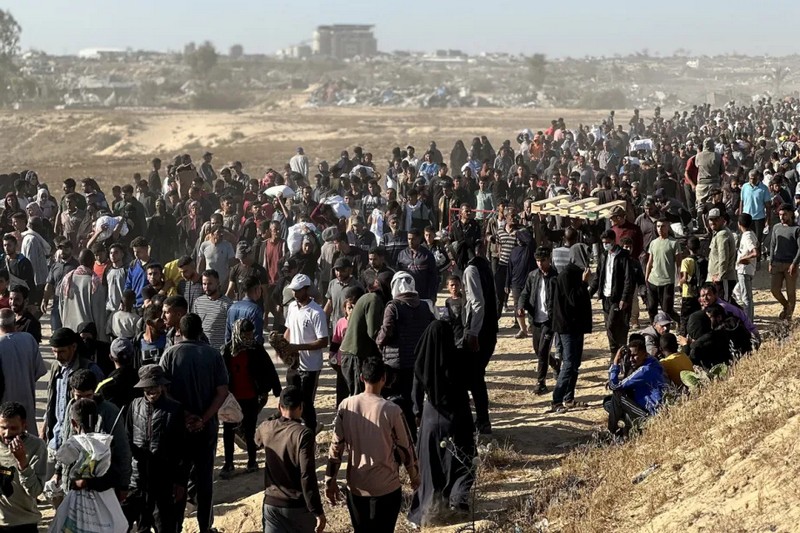By Quds News Network
On March 2, Israel announced the closure of Gaza’s main crossings, cutting off food, medical and humanitarian supplies, worsening a humanitarian crisis for 2.3 million Palestinians, according to reports by human rights organisations who have accused it of using starvation as a weapon of war against Palestinains.
On May 27, the controversial US-backed Gaza Humanitarian Foundation (GHF) began its operations in the Gaza Strip, opening its first of four distribution points in Rafah in southern Gaza.
After more than 80 days of total blockade, starvation, and growing international outrage, limited aid has allegedly been distributed by the GHF, a scandal-plagued organization backed by the US and Israel, created to bypass the UN’s established aid delivery infrastructure in the Gaza Strip.
Most humanitarian organisations, including the UN, have distanced themselves from GHF, arguing that the group violates humanitarian principles by restricting aid to south and central Gaza, requiring Palestinians to walk long distances to collect aid, and only providing limited aid, among other critiques.
One in five people in Gaza currently face starvation due to the Israeli blockade of food and aid while 93 percent are experiencing acute food shortages, according to a UN-backed assessment released last month.
Through the GHF, Palestinians in Gaza would receive a “basic amount of food,” according to Jake Wood, who resigned as executive director of the foundation two days before the GHF started its operations. Wood said a statement that the group’s plans could not be consistent with the “humanitarian principles of humanity, neutrality, impartiality, and independence.”
“Herded Like Animals into Fenced-Off Pens”
Palestinians have also complained about the rush to secure packages inside the distribution centres and the failure of the guards to maintain order. The instructions given to Palestinians are reportedly confusing and contradictory.
Photos and videos circulated on social media at one of GHF’s distribution sites near the so-called Morag Corridor in Rafah showed large crowds lining up in front of metal fences topped with surveillance cameras.
Witnesses described a slow and tightly controlled entry process, with people funnelled through narrow fenced corridors that resembled cattle chutes. Once inside the distribution area, people were subjected to ID checks and eye scans to determine who was permitted to receive aid.
Former UNRWA spokesperson Chris Gunness criticized the Israeli-US aid distribution mechanism, saying it has turned Gaza into a “human abattoir”.
“Hundreds of civilians are herded like animals into fenced-off pens and are slaughtered like cattle in the process,” Gunness said.
“Human Slaughterhouses”
Moreover, since its operations in Gaza, over 130 starving aid seekers waiting for food aid near GHF distribution centres have been killed and 1000 others injured by Israeli forces within two weeks, according to the Palestinian Health Ministry on Monday.
At least nine others are still missing, the Ministry added.
In a statement, Gaza’s Government Media Office condemned the distribution sites as “human slaughterhouses” and “mass death traps”, accusing Israeli forces of luring desperate civilians to their deaths.
“These are war crimes and crimes against humanity,” the statement said, urging an independent international probe and an immediate suspension of GHF’s delivery model.
Here’s a timeline of Israeli attacks on Gaza aid seekers near the GHF’s sites:
- Tuesday, May 27: 3 killed, 46 wounded, 7 missing in Rafah
- Wednesday, May 28: 10 killed, 62 wounded in Rafah
- Sunday, June 1: 35 killed, 200 wounded in Rafah; 1 killed and 32 wounded, 2 missing at the Gaza Valley Bridge
- Monday, June 2: 26 killed, 92 wounded in Rafah
- Tuesday, June 3: 27 killed, 90 wounded in Rafah
- Friday, June 6: 8 killed, 61 wounded in Rafah
- Sunday, June 8: 13 killed, 135 wounded in Rafah and near Gaza Valley Bridge
Pick a Lie, Any Lie
The Israeli military has, on at least four occasions, admitted to opening fire on aid seekers near GHF sites in Gaza, while offering multiple, often contradictory, stories in an effort to deny responsibility for the killing of desperate, starving civilians. Rather than providing clarity, each version has only deepened the confusion. This apparent attempt to evade accountability has drawn sharp criticism from human rights organizations and international observers.
In one account, the military claimed there were no casualties from the incident. However, the International Committee of the Red Cross (ICRC) confirmed that 21 bodies had been brought to its field hospital in Rafah.
Israel’s disinformation campaign has drawn comparisons to previous instances of misleading narratives, including efforts to justify attacks on UN schools, hospitals, and shelters in Gaza.
Observers warn that the spread of fake videos and constantly shifting stories cannot obscure the facts. “The massacre in Rafah is documented,” said Rami Abdu, director of the Euro-Med Human Rights Monitor. “No amount of propaganda can whitewash a war crime.”
10 June 2025
Source: countercurrents.org

